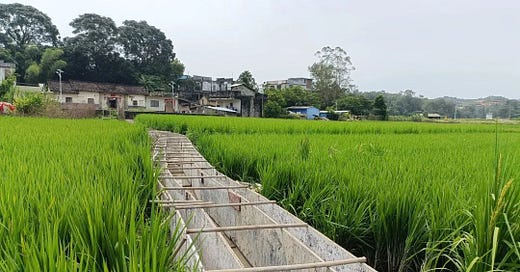Hey Beijing watchers!
so this post now kicks off our ag theme for the week.
Philippa
Amid the expected infrastructure boom to support GDP growth, the neglected rural sector looks set to benefit. Rural infrastructure spending stepped up in the spring. Backed by eight central departments, a work plan issued in mid-October further advanced existing projects and launched new ones in batches touted to achieve ‘solid results’ by year’s end.
Pumping the domestic economy via massive public investment is nothing new; recall high-speed rail, airports, bridges, et al. This latest campaign directed to rural projects aims at two fronts: GDP stimulus and a boost to food production and security through structurally improving farmland.
farmland thirst unquenched
Heatwave and drought—the worst on record—ravaged the south through the growing season. Rice-producing hubs in the Yangtze catchment were severely hit. Avoiding mention of serious damage, central statistics glossed over the harsh reality. Local reports, nonetheless, lamented falls in output and grain quality. Over 25 percent of Jiangxi’s total farmland was at risk; complete crop failure is claimed to have only affected some 76,000 ha (or 3 percent of the province’s total), while other areas suffered to varying degrees.
Rural water systems were barely able to save the critical autumn harvest. In Jiangxi province alone, some 25 percent of its farmland either lacks irrigation or the facilities to deliver needed water. A broken ‘last mile’ of irrigation is reported in Inner Mongolia, a blend of financial and maintenance shortfalls. Other provinces suffered similar shortfalls.
So the priority given to water projects in investment plans comes as little surprise. Medium- and small-sized reservoirs and cisterns in villages are to be built. More effective irrigation networks will send water to farmland and drain wet fields after rainfall and floods. For many years the network has sat around 50 percent of farmland (see chart).
Potable water supplies are another target. Tap water is touted to rise from 84 to 88 percent in rural areas by 2025. Some 60 percent of the rural population should benefit from large-scale supply projects.
beyond traditional farming
Controlled-environment agriculture (CEA)—usually indoor or vertical ag—is the major production-related project to be targeted in the infrastructure boost. Currently small-scale and low-tech, new projects will focus on multispan greenhouses and plant farms. CEA investment will flow to fisheries, too, both marine ranching and freshwater aquaculture.
Mention of cold chain logistics also peppers central documents. The current plan envisages it reducing post-harvest food losses and ensuring the quality of produce that reaches consumers. Small-scale refrigeration at the farmgate, cold-chain initial processing and distribution centres in production areas, and large regional logistics hubs are among the cold facilities to be built. We will look at this more closely in our next post.
leveraging private investment
Despite a shocking year, fixed asset investment in the primary sector was C¥1 tn over Q1-3 2022, up 1.6 percent y-o-y. But investor confidence was certainly down on the average 13.2 percent growth of the past two years.
Both the China Development Bank and Agricultural Development Bank of China set up their own infrastructure investment funds in July, offering development finance to attract investment. Within two months, C¥300 bn was allocated to an array of projects, including in rural regions. A further C¥300 bn followed from the State Council. Public funds typically provide less than half the initial investment, while project partners and private capital, sourced elsewhere, make up the rest. This new capital injection from development banks has sped up some major projects that otherwise would have been dropped due to a lack of matching private funds.
Leading infrastructure investment, public institutions valiantly seek to attract private capital. Public-private partnership (PPP) is claimed to be a feasible path for engaging much-needed funding from professional market players—sceptics often dub the projects public-public projects.
Private investment remains weak amid COVID controls and falling confidence, eroding the prospects for the stimulus strategy. Reactivating rural regions is deemed urgent, but the huge initial investment, long project cycles and low returns typically leave investors cold.
A bright spot post the 20th Party Congress is that rural projects in the New Era of Common Prosperity may now make political, rather than financial sense, to investors.






Excellent news.. Looking forward to the next update..
Thank you for this China wisdom feed! For China agricultural economics, I also enjoy the Dim Sums blog at https://dimsums.blogspot.com/ and the USDA Foreign Agricultural Service China reports at the bottom of the page at https://fas.usda.gov/regions/china